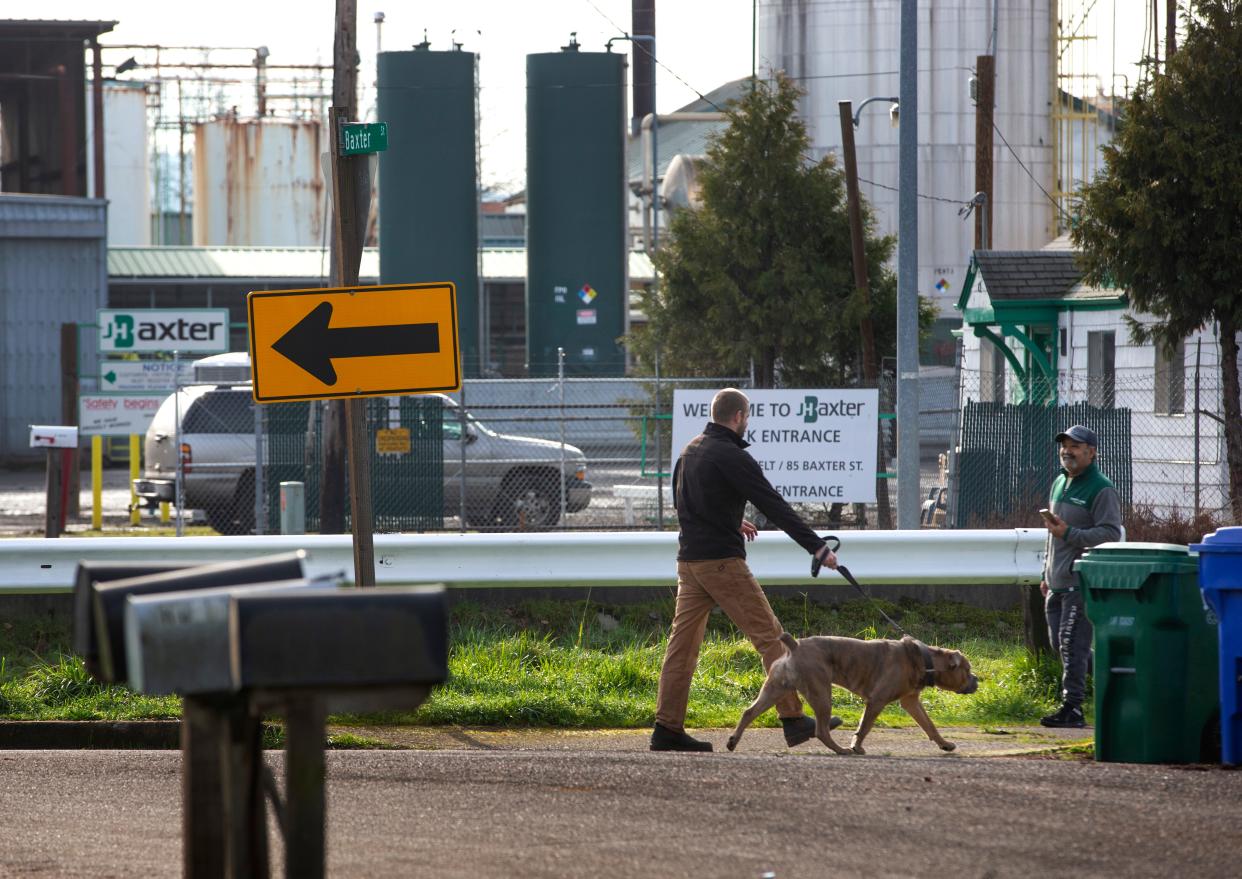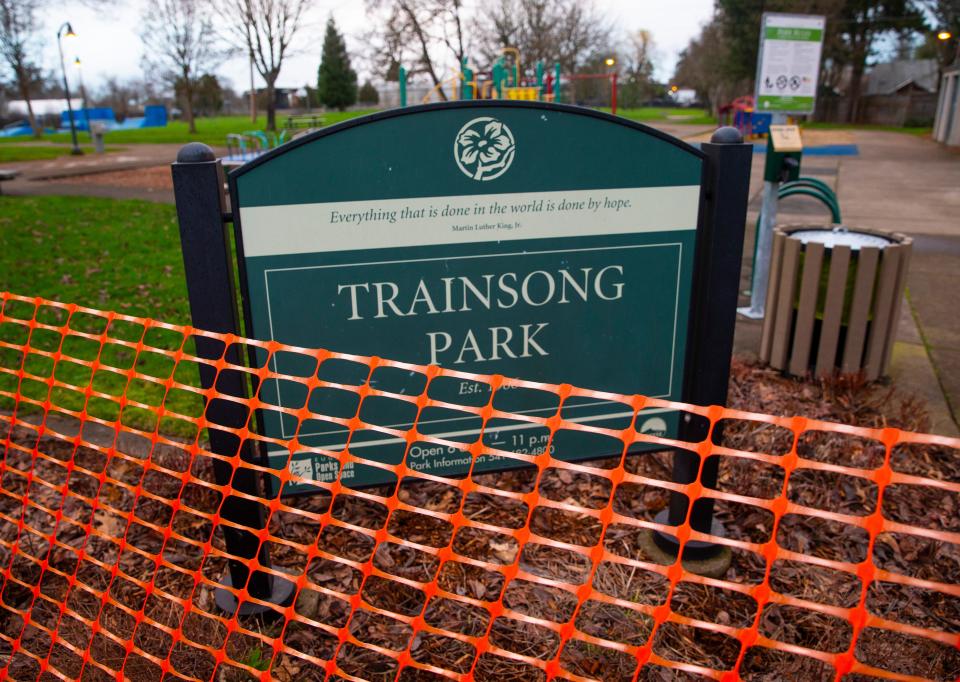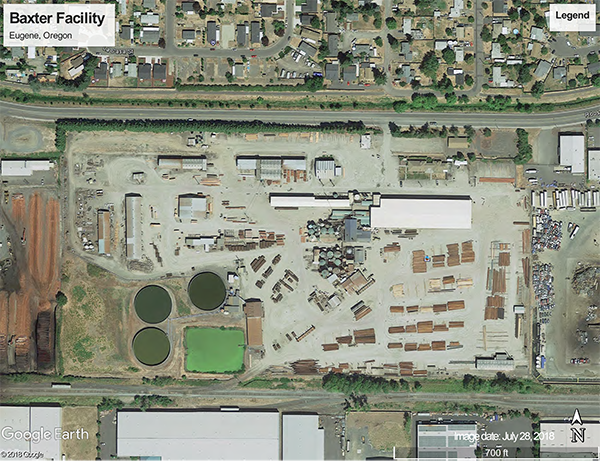Oregon DEQ finds carcinogenic compounds in west Eugene yards around J.H. Baxter & Co. plant

The soil of at least six west Eugene homes is contaminated with toxic chemicals state regulators believe originated with the activities of one of their industrial neighbors.
The Oregon Department of Environmental Quality announced Thursday soil samples in west Eugene show high levels of dioxins, a class of toxic compounds generated during some industrial processes. DEQ believes operations at the wood treatment company J.H. Baxter & Co., a longtime source of pollution, are responsible for the contamination.
DEQ has discovered dioxins in soil samples from seven yards around the J.H. Baxter & Co. facility on Roosevelt Boulevard before, but the latest sample results are the first evidence of those chemicals at nearby residences. Six of the homes' yards require cleanup and soil replacement.
"I'm very sad, but also not really surprised," said Rose Mede, who lives at one of the properties where dioxins were found. "Just watching the plant and smelling the smells in the air, it doesn't take a chemist to know it's got to be toxic."
DEQ will be working with J.H. Baxter on a cleanup plan for those properties, according to DEQ spokesman Dylan Darling.
Dioxins are carcinogenic. DEQ has informed residents where dioxins were found of the results and provided them with advice on precautions to take until the cleanups occur.
Dioxin molecules bind to soil particles and people are exposed to it by swallowing small amounts of soil, according to letters DEQ sent affected residents.
More on J.H. Baxter:Toxins found again in soil near J.H. Baxter wood treatment facility in Eugene
Third-party consultants took the samples in September and October and analyzed them as part an on investigation into dioxin contamination near the facility, according to DEQ.
Dioxin levels at three of the residences require removal of contaminated soil as soon as possible, likely to be conducted this summer. Three properties need eventual cleanup to avoid health risks. Dioxins were found at a seventh residence, but cleanup isn't needed.
"It's not the healthiest area to live, I know that," said Rob Landwehr, whose soil will have to be replaced. "They did say they would tear up and re-do the yard. I'm sure that's probably a year down the road or better. It sounded like they have to do more testing now to figure out the extent of how far it goes."
A second round of soil sampling on residential properties in west Eugene is expected to begin soon, according to a DEQ news release. Additional sampling will help determine the extent of the dioxin contamination around the properties already tested, DEQ said.

DEQ took control samples from other areas as part of the investigation. One soil sample taken from Trainsong Park in west Eugene also showed elevated levels of dioxins, but it doesn't appear related to the J.H. Baxter & Co. site, according to the DEQ news release.
It is not yet known how dioxins contaminated park soil.
The dioxin presence is troubling, but the risk they pose appears low, according to DEQ.
"A family with young children would have to visit the park four days per week for an entire year before there would be any risk of health effects," the news release said.
DEQ is working on next steps at the park with Eugene and the Oregon Health Authority.
The city of Eugene temporarily closed the park Thursday until more testing is complete.
'This is a wake-up call'
Neighbors of the J.H. Baxter & Co. plant have complained for years of foul odors and sickness. Studies have noted unusual cancer rates around the site without linking them.
Complaints: Neighbors fear J.H. Baxter & Co. plant is harmful to health
Beyond Toxics, a local nonprofit, has been one of the company's most vocal opponents. Executive Director Lisa Arkin said the dioxin levels are frightening, but not unexpected.
"I'm not surprised that the agency found high levels of dioxins in the yards of residences, but it still is, in a way, disheartening to know that this kind of very poisonous substance is in people's yards where their children play," Arkin said. "We're not at any point yet where we can say 'dioxins cause cancer in west Eugene,' but this is a wake-up call."
J.H. Baxter & Co. President Georgia Baxter did not respond to an email seeking comment.
DEQ delivered letters to residents where dioxins were discovered informing them of the findings and recommending precautions to minimize tracking yard dirt into their homes.
"The letter they're sending to people are scary," Arkin said. "I'd be terrified if I received a letter from DEQ saying there's dioxin in the soil on my property. I would also be furious because it not only affects the health of my family but it affects my entire community."

Not the company's first fine
The J.H. Baxter & Co. facility has a long history of environmental and pollution issues.
The Lane Regional Air Protection Agency in 2004 logged more than 700 complaints from 100 homes near the plant that alleged sicknesses had been caused by plant fumes.
DEQ at that time also discovered arsenic in soil at the facility and pentachlorophenol, an industrial wood preservative, spreading in the aquifer underneath the neighborhood.
The company spent hundreds of thousands of dollars in trying to mitigate the damage.
Between 2017 and 2019, DEQ fined the company for hazardous waste and water quality violations, including eight instances of polluted water draining offsite into Amazon Creek.
The U.S. Environmental Protection Agency in 2018 fined J.H. Baxter & Co. $64,000 and required it to build on-site protections meant to prevent toxins contaminating nearby soil.
In 2019, the company and regulators agreed to a cleanup plan that was meant to reduce the occurrence of soil and groundwater contamination at the company's 31-acre facility.
DEQ in March 2021 fined J.H. Baxter $223,440 for an assortment of alleged violations. That included $178,905 for pumping 1.7 million gallons of industrial process waste into devices that evaporated the liquid, containing various hazardous chemicals, into the air.
In a letter of appeal concerning the DEQ fines, J.H. Baxter & Co. admitted it used those machines to boil off the process waste but argued DEQ lacks authority to regulate that.
DEQ and J.H. Baxter & Co. have not yet resolved the issue.
LRAPA also fined the company in 2019 for violations related to boiling off the waste.
LRAPA has conducted eight enforcement actions at the J.H. Baxter & Co. plant since 1994, according to agency records. Four included penalties between $800 and $4,000.
Several class-action lawsuits are currently active concerning the company's operations.
Focused on risks: Cleaner Air Oregon regulatory process to engage Lane County community in public health risks
The J.H. Baxter & Co. facility is one of the local industries first included in LRAPA's plan to enforce the rules of Cleaner Air Oregon, a 2019 law putting more than 600 chemicals under state regulations and evaluating facilities' obligations based on local health risks.
LRAPA hasn't yet conducted an emissions inventory at the facility, the first step in the CAO process. The process could eventually result in new regulations for the facility.
Editor's note: This story was updated to clarify how many homes have soil contaminated enough to require cleanup and replacement.
Contact reporter Adam Duvernay at aduvernay@registerguard.com. Follow on Twitter @DuvernayOR.
This article originally appeared on Register-Guard: DEQ finds carcinogenic compounds in yards around J.H. Baxter in Eugene

